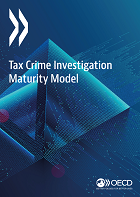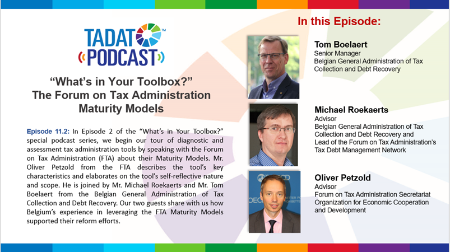OECD Tax Administration Maturity Model Series
What are maturity models?Maturity models are a relatively common tool, often used on a self-assessment basis, to help an organisation understand its current level of capability in a particular functional, strategic or organisational area as well as the type of changes that would be likely to enable the organisation to reach a higher level of maturity over time. Maturity models work by setting out broad-brush descriptions of capabilities and performance across a number of levels of increasing maturity. Maturity models are generally descriptive in nature, with a focus on processes and the broad outcomes of those processes, rather than being heavily based on metrics. This recognises that even where the metrics chosen may indicate a good or less good outcome, they do not by themselves show how that outcome has been achieved, the sustainability of the outcome or its robustness and adaptability to changes in the external environment. By their nature, maturity models are not prescriptive as to the details of processes nor as to how broad outcomes should be achieved. There is no one-size-fits-all nor any detailed method that should be preferred to another in all circumstances. |
Want to learn more?In a TADAT podcast episode (June 2021), the FTA Secretariat together with colleauges from the Belgian General Administration of Tax Collection and Debt Recovery describe maturity models' key characteristics and elaborate on the use of maturity models to support reform efforts. Listen to it in Arabic, English, French, Mandarin, Portuguese, Russian, and Spanish on the following digital platforms: Soundcloud, Podbean, Apple podcasts or Spotify. |
The FTA maturity models
The OECD Forum on Tax Administration (FTA) first developed a maturity model in 2016 in order to help tax administrations assess digital maturity in the two areas of natural systems/portals and big data. The digital maturity model was introduced in the 2016 OECD report Technologies for Better Tax Administration.
Building on this, work began in 2018 to develop a set of stand-alone maturity models covering both functional areas of tax administration, such as auditing and human resource management, as well as more specialised areas such as enterprise risk management, analytics and the measurement and minimisation of compliance burdens. In designing the maturity models, it was decided to use the middle level, termed "Established", to provide a description of where, on average, FTA members may be expected to cluster. Using this as an anchor, the other levels of maturity were fleshed out providing a pathway from "Emerging" to "Aspirational" with the latter maturity level seeking to describe what might be possible in the future given expected developments. There is also no judgement within the models themselves as to what the optimal level is for a particular tax administration. This will depend on their own circumstances, objectives and priorities.
The aim is that over time a series of tax administration maturity models will be published in downloadable format covering a wide range of tax administration activities. The intention of the models is:
- To allow tax administrations to self-assess through internal discussions as to where they see themselves as regards maturity in various activities and functions.
- To provide officials working in an area, including senior leadership of the tax administration, with a good oversight of the level of maturity based on input from other stakeholders across the organisation.
- To help facilitate discussions on future strategy as well as identifying areas for further short-term improvement, including where that needs to be supported by the actions of other parts of the tax administration.
- To allow tax administrations to see where they sit compared to their peers.
 |
Published on 22 June 2022
The Analytics Maturity Model helps tax administrations to assess their analytics usage and capability, providing insight into current status and identifying areas of weaknesses as well as strengths. The model is organised around the strategic and operational perspectives of analytics. To assist in the understanding of what a given level of maturity means, a set of indicative attributes is contained under each maturity level. In addition to the model itself, the report offers guidance for how to perform a self-assessment based on the model. It also summarises the anonymised results from the over forty administrations that have participated in the piloting process, as an aid to understanding the current status of analytics use and capabilities in tax administrations.
|
|
|
Digital Transformation Maturity Model Published 16 December 2021 | Updated 27 September 2022 The Digital Transformation Management Maturity Model covers the key building blocks of future tax administration. This model is one of the first outputs following the OECD FTA’s publication of the Tax Administration 3.0 Vision in 2020. Digital transformation refers to the fundamental changes in the way that tax administrations operate, responding to the changes in how taxpayers interact and conduct business with each other. In particular, this transformation is centred around the increasing migration of taxation processes into taxpayers’ natural systems, i.e. the systems they use in their daily lives and/or businesses. |
|
|
Enterprise Risk Management Maturity Model Published 9 February 2021 This maturity model covers the organisational and operational aspects of risk management. The ability to identify, understand and manage risks in a rapidly changing environment is a critical element of successful and resilient tax administration. The model was developed by a group of Forum on Tax Administration (FTA) members and refined through a pilot undertaken by members of the FTA’s Enterprise Risk Management Community of Interest. This publication also sets out the results of that pilot which allows administrations using the model to compare their own maturity in the different aspects of enterprise risk management to that of their peers. |
|
|
Tax Debt Management Maturity Model Published 23 December 2019 This maturity model covers one of the major tax administration functions, employing around 10 per cent of tax administration staff and dealing with outstanding collectible debt of around EUR 820 billion across FTA members (2017 figures). The model was developed by a group of FTA members and refined through a pilot undertaken by a wide range of tax administrations, including some developing countries. This report sets out the results of that pilot which allows administrations using the model to compare their own maturity in the different aspects of tax debt management to that of their peers. |
|
|
Tax Compliance Burden Maturity Model Published 23 December 2019 This maturity model looks at the core elements of successful compliance burden measurement and management, including engagement with policy makers. This is an increasingly important cross-cutting consideration for tax administrations as excessive compliance burdens can both undermine tax compliance as well as adversely impact economic growth. The model was developed by a group of FTA members and refined through a pilot undertaken by a wide range of tax administrations, including some developing countries. This reports sets out the results of that pilot which allows administrations using the model to compare their own maturity in the different aspects of compliance burden measurement and management to that of their peers. |
Other tax-related maturity models
 |
Tax Crime Investigation Maturity Model Published 30 November 2020 The OECD has also published a Tax Crime Investigation Maturity Model which aims to to help jurisdictions understand where they stand in the implementation of the OECD's Fighting Tax Crime: The Ten Global Principles, based on a set of empirically observed indicators. By setting out indicators for each increasing level of maturity, the model also charts out an evolutionary path for future progress towards the most cutting-edge practices in tax crime investigation across four levels of maturity: Emerging, Progressing, Established and Aspirational. It therefore also serves as an important tool for measuring the impact of tax crime capacity building interventions, including those promoted by the Addis Tax Initiative and G7 Bari Declaration. The model also has relevance for jurisdictions at all stages of development. |
Related Documents






